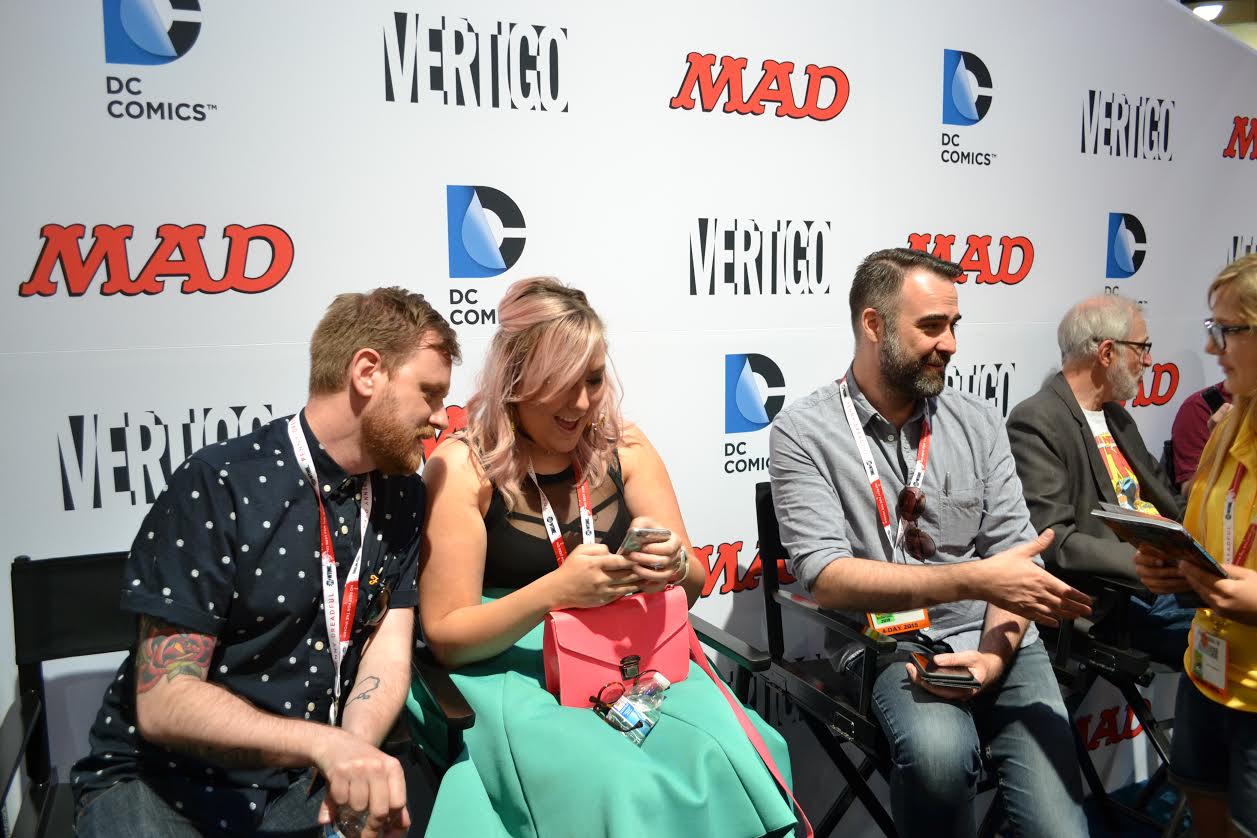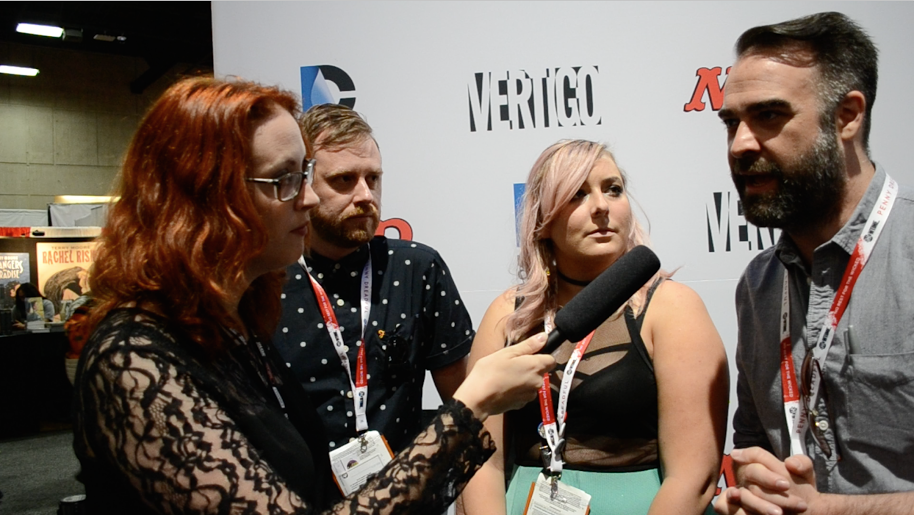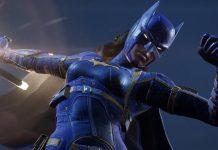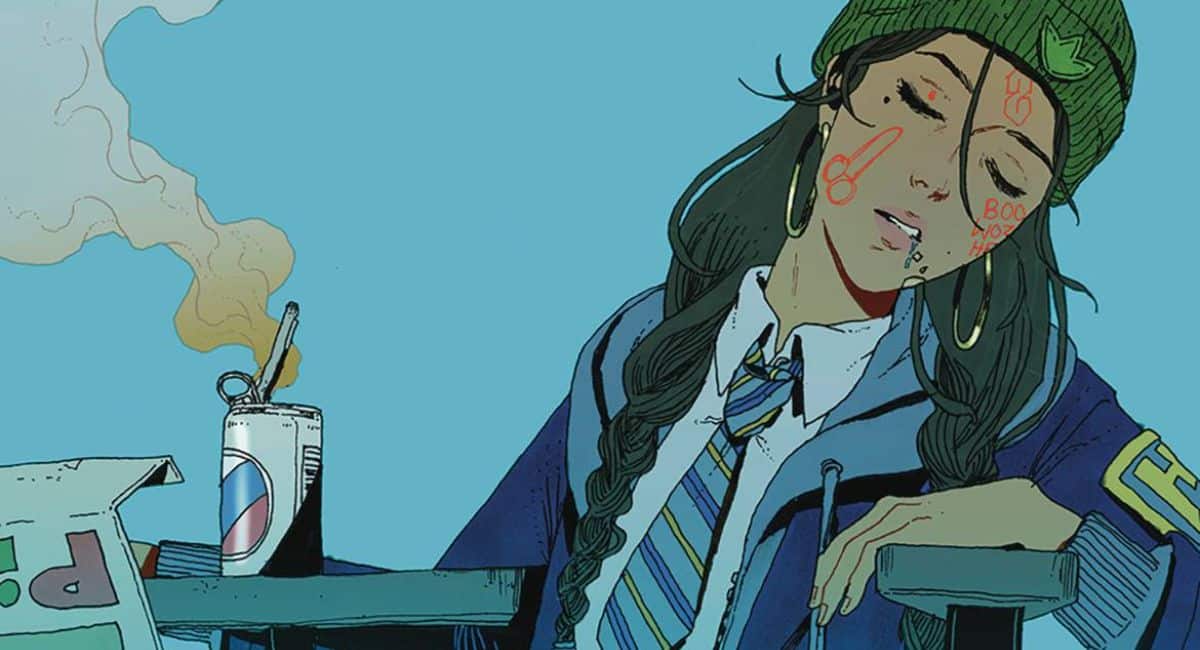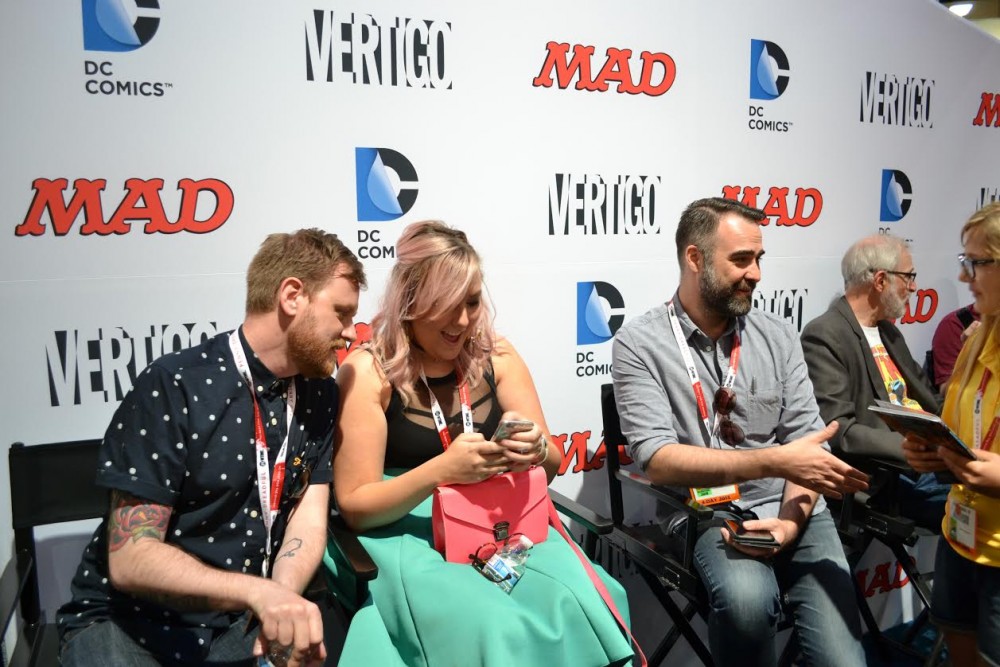
It’s 11am on Saturday at SDCC, and the DC Comics booth is buzzing — quite literally — with large packs of fans craning their necks and smart phones to catch a glimpse of the latest DC trailers, and answering trivia questions to win prizes. But I’m not focused on those loud bells and whistles. My mind is 100% Batgirl as I watch the creative powerhouse team of writers Cameron Stewart, Brenden Fletcher, and illustrator Babs Tarr file into the roped-off interview area.
Batgirl has become my unlikely entry point into the main DC Universe. Of the big two, I’ve always been a Marvel fan — the only DC I read was Vertigo. But Gail Simone’s New 52 Batgirl reboot from a darker past, full of questionable editorial choices, got me interested. From there I went back to classics like Batgirl: Year One and fell hard for Babs Gordon as Batgirl.
I found myself further charmed by The Batgirl of Burnside and so jumped at the chance to interview Stewart, Fletcher and Tarr: the team behind the book. But before the nervous growling in my stomach could settle, a young girl walked up to Fletcher in a yellow t-shirt embroidered with the logo of his other book Gotham Academy. When I heard her say: “Gotham Academy got me into comic books” I told DC’s Clark Bull that she should take all the time she needed.
When my turn came, I was pleased to hear from Stewart that he regularly reads The Beat — something a lot of people I met at SDCC shared with me. I talked with the Burnside Batgirl crew about their creative origins, how the look that launched a thousand cosplays came to be, how to handle creative criticism, and their earliest con experiences.
So tell me about the origin story of how you all came to work together on Batgirl.
Cameron Stewart: I got a call from — at the time — the editor of the Batgirl book. The current writer, Gail Simone, was departing. They wanted to bring somebody new in, but they wanted to change it up a bit, to kinda go in a different direction, try and inject some fresh life into it. So I was asked if I wanted to take it over as writer and artist.
Unfortunately, I really wanted to do it, but I didn’t have the time, because I’d just taken on another job. So I thought, “how about if I’m still able to be involved, but bring in some friends of mine?” People that I wanted to work with, that I thought would not only help me have the time to do it, but bring some stuff to it that I wasn’t able to bring to it.
So I brought in my friend Brenden, as co writer, whom I’ve been friends with for like 15 years, we’re old friends. He and I have always had very similar ideas about comics, about the direction of particular superhero characters. And I found Babs on the internet! I was following Babs for years on tumblr and instagram, I just love her work and I knew that we wanted to work with a young woman and have her voice present.
I wanted someone whose work showed an animation influence, was really stylish and knew a lot about fashion and contemporary culture — and she just hit all those beats. So I emailed her and said,”I can’t tell you what it is yet,” because I didn’t have the job yet, but I was like: “I’m working on a book maybe for DC comics and I think you’d be good drawing it, would you wanna do that?” And she didn’t believe that it was a real thing.
Did you flip out?
Babs Tarr: I was like, “just a couple problems: I’ve never drawn comics before?” And my style didn’t look like anything DC was publishing at the time, so I kinda got the email and I was like: “I’m really flattered, but okay let me know when DC wants to hire me.” Like I didn’t quite believe him. But eventually, I got an email from you [indicating Stewart] and it was like: “okay, it’s down to two artists!” And then I was like, “Oh my god that’s real! That’s a real thing happening right now!”
I did a couple test pages for DC because I hadn’t done comics before to show them that I had at least the bones to build some skin on —
Stewart: Yeah, a solid foundation.
Tarr: And then I got offered the title the very next day after I submitted them.
And the rest is history! So I wanted to ask: did you feel intimidated by the success of Gail Simone’s run —
Tarr: Yes.
How did you balance honoring the look and personality of her Batgirl with your personal take on the character, both look and story?
Fletcher: I think from a story standpoint, what we were doing was approaching Barbara Gordon’s current psychological state. She is a woman who is suffering PTSD, and she continued going through all of these really dark, challenging things in her life and you could see through the arcs that the Batman editorial group were putting her through that it was pushing her to a limit.
We took that as our cue to take the character and make her realise that this was a place that she didn’t want to be and to pull away from it, and to make great changes in her life. And that allowed us to re-examine who Barbara Gordon is, and allow her to find where her happy place is, really. Let the character be comfortable, happy, and be the best Batgirl that she could possibly be. And that was the goal for our first arc.
In designing the new, and much lauded outfit — deservedly so — did that come before you decided on your interpretation of who this Barbara Gordon would be? Or did the design help lead to the personality?
Stewart: I think it was a bit of both? I knew I wanted to design something that was very fun. I wanted to do a fun, bright comic that was kind of not really what DC was doing at the time. I wanted to stand out and be the comic that was the kind of fun, bright, pop-y thing. And also since the lead character is a 21-year old young woman, I wanted to do something that was kind of reflective of that and be the kind of costume that a young woman might actually want to wear aside from being a superhero. Something that was cool and fashionable.
So that was the starting point, and yeah, it just came from there. And it came from studying contemporary fashion and trying to make something that would resonate with the audience we were trying to attract, which was young women.
[To Tarr] And that’s where you come in.
Tarr: Yeah, Cameron had this great base costume design. And when you handed it to me, and I added a little detail to it, to contemporize it, look like something she could’ve picked up out of a thrift store. We wanted it to be her own, like she owned it, it wasn’t a costume that Batman provided for her. Like she went out and picked out all the things herself. We even have a great page, a montage page —
I love that page!
Tarr: Where she’s like, sewing and there’s little needles in her mouth and she’s doing it.
People have said, In contrast to the sort of, Spider-Man, “how did he make that with no design background?” That [Batgirl] was very realistic.
Tarr: and like, girls are kinda craftier, so she could, definitely! [laughs]
And who was [responsible for] the snaps on the cape?
Stewart: That was me.
That was you? Bravo. I just I had to get that in there because that’s so great. That’s so long we’ve needed that.
There’s a real sense of joy in your run on Batgirl, there’s excitement, believing she can actually make a difference in Gotham. How do you balance the depth of Batgirl, both her art and her story without making her seem frivolous or too precious?
Fletcher: I think that’s seemed like a challenge, or seemed like we were challenged by it? By a lot of the readers, the perception that they’ve had the things that we’ve had said to us? Like, she seems…
Tarr: They see the selfie cover, and then they assume —
Fletcher: But in fact it was part of the arc, it was part of what we were putting her through, to push her to the other side of it. Where she wasn’t so ensconced in the Bat-world and in the darkness, and trying to be a young person again and trying to feel like she could have frivolity in her life without losing who she was.
We put her through that in the first issue of our arc, you see that all of the trials and tribulations that she goes through in the subsequent issues are a result of that. So our first arc is her finding that balance, so what you get in the trade paperback, the hardcover that just came out, volume one, is that story of how she attempts to have a bit of frivolity in her life, but maybe goes to far and pulls back and finds her center.
Tarr: And I like it as a girl, ‘cause it’s like, just because you take selfies doesn’t mean you’re shallow or an airhead. And I feel like we show that.
I take far too many selfies.
Tarr: Right? So it’s just like: that doesn’t always hand in hand, like people shouldn’t assume. And I feel like our Batgirl fights that ideal a little bit.
Fletcher: Part of the first arc is like her claiming her own image and defining who she is. And that’s part of it.
Have you heard of the #365feministselfie project?
Tarr: No!
It’s a project where media critics and feminists came together and took a selfie every day as an act of owning your own image. So the selfie cover — I think maybe some people came on the wrong side of that. I thought it was effective.
So: many comic fans that I know personally were actually really impressed by how your team handled the criticism of the Dagger Type character, and I wondered how that experience informed how you move forward with Batgirl?
Fletcher: Woah. [looks to Stewart] Go for it. Yeah, you can handle the heavy ones.
Stewart: Yeah! I mean it was kind of an unfortunate blind spot that we had, and we —
Tarr: We listened. And we fixed it for the trade.
Stewart: We took the criticisms to heart. It hit us pretty hard when we read about it. We paid a lot of attention, and we were very careful in considering what to do next. We feel really good about it, we took the criticism to heart and tried to make really positive changes. For me, even, I think, for all of us, aside from being comics creators –just from people. I think it was a really positive step forward for me, it opened my eyes to a lot of stuff that it’s —
Tarr: That it’s a blind spot.
Stewart: Yeah, absolutely. I think it’s something that’s made me better, and more aware, as a person.
Tarr: Yeah, all of us, the whole team.
Did you consult with any younger siblings, cousins, friends, to help keep the youthful vibe of the book authentic?
Tarr: I handle all of that [laughs].
You do all that? You’re the youth vote?
Tarr: [laughs] Yeah! Well I’m 27, so I’m not too far from a 21 year old, I definitely was in that spot where I’m trying to afford to buy cute clothes and also go to school and balance your social life with your school life. And Babs just has that extra layer of also balancing a crime-fighting life. I tried to make it super relatable.
Stewart: Which is the reason why we brought her onboard.
So you just have to stay forever young in mind [laughs].
Tarr: [laughing] That’s the goal.
Last question: what was your first comic con experience, either as a creator or as a fan?
Stewart: San Diego or any con?
Any con.
Fletcher: Oooh I’ve got a good one. The very first con I went to was the debut of Image in Chicago. It was the Chicago Comic Con where Image had this big party —
Tarr: What year was that, Brenden? [laughs] 19–*coughs*
Fletcher: Yeah, it was 1965. And it was Karl Kerschl, my illustrator for Gotham Academy and I showing up there I think we were, what, 17 or something? Guys who just wanted to make comics and we met all of the creators. We met Jim Lee, basically we idolized Jim Lee, so it was a moment where we couldn’t talk. We just stood in front of him and went: “uhh, uhh” *with jaw dropped*
And Karl showed his portfolio for the very first time to anyone at that convention and it was to the line of creators there: Todd McFarlane, Erik Larsen, Jim Valentino. It was a huge experience. And then we just spent the weekend being dazzled by — oh, actually, this is a better one! Our very first meeting, sitting there, in the audience waiting to meet those guys was Hank Kanalz! What’s his position now at DC? VP of…?
Stewart: Something important. [Kanalz is Senior VP of Publishing for Vertigo and Integrated Publishing at DC]
Fletcher: Hank is VP of something very important at DC now, and he was the very first person I ever met in comics, and he sat with Karl and I and just talked to us about what it’s like to be working in comics.
He was really generous to you.
Fletcher: It was so important.
So does that sort of inform now how you relate to fans in this environment?
Fletcher: Absolutely. When I have young people sit with me, or they come to a signing…
Like that Gotham Academy fan who just came by before!
Fletcher: That’s right! It literally just happened. And I always think back to Hank talking to Karl and I when we were like 17. Amazing.
Any con experiences you guys want to share?
Stewart: I would not have a career if I wasn’t at San Diego Comic Con. It was meeting an editor at DC Comics here that launched my whole career.
Tarr: This is kind of like a bookend for me, because my first book and my first time I met these guys and my first time as a comic creator was this con last year. So it’s like a one-year anniversary for all of us.
The trade paperback collection of Batgirl Vol. 1: The Batgirl of Burnside is available now. Follow the writers and illustrator on twitter: Cameron Stewart, Brenden Fletcher, and Babs Tarr. Tarr’s instagram, that nabbed her the job on Batgirl, is here.


